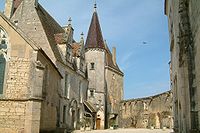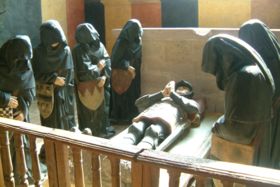
Château de Châteauneuf
Encyclopedia

Châteauneuf, Côte-d'Or
Châteauneuf or Châteauneuf-en-Auxois is a commune in the Côte-d'Or department in eastern France.-Population:-Sights:Châteauneuf is dominated by its château, which was given in December 1456 by Philip the Good to Philippe Pot, whose renovations and fortification gave to it the aspect it retains...
, 43 km from Dijon
Dijon
Dijon is a city in eastern France, the capital of the Côte-d'Or département and of the Burgundy region.Dijon is the historical capital of the region of Burgundy. Population : 151,576 within the city limits; 250,516 for the greater Dijon area....
, in the Côte-d'Or
Côte-d'Or
Côte-d'Or is a department in the eastern part of France.- History :Côte-d'Or is one of the original 83 departments created during the French Revolution on 4 March 1790. It was formed from part of the former province of Burgundy.- Geography :...
département of France
France
The French Republic , The French Republic , The French Republic , (commonly known as France , is a unitary semi-presidential republic in Western Europe with several overseas territories and islands located on other continents and in the Indian, Pacific, and Atlantic oceans. Metropolitan France...
. It is a vast stone building, 75 metres in length and 35 metres broad, situated on a rocky outcrop 475 metres above the surrounding plains. It dominates the valley of Canal de Bourgogne.
History
The castle was built in 1132 by Jean de Chaudenay for his son Jehan, who took possession of it in 1175 and became Jean I de Châteauneuf. Facing the threat of the Hundred Years' WarHundred Years' War
The Hundred Years' War was a series of separate wars waged from 1337 to 1453 by the House of Valois and the House of Plantagenet, also known as the House of Anjou, for the French throne, which had become vacant upon the extinction of the senior Capetian line of French kings...
, the lords of Châteauneuf then built the powerful fortifications around the 12th century keep. After nine generations in the castle, the reign of the Châteauneufs ended in tragedy when in 1456 the last heiress, Catherine de Châteauneuf, was burnt alive for poisoning her second husband, Jacques d'Haussonville.

Philip III, Duke of Burgundy
Philip the Good KG , also Philip III, Duke of Burgundy was Duke of Burgundy from 1419 until his death. He was a member of a cadet line of the Valois dynasty . During his reign Burgundy reached the height of its prosperity and prestige and became a leading center of the arts...
, duke of Burgundy
Duchy of Burgundy
The Duchy of Burgundy , was heir to an ancient and prestigious reputation and a large division of the lands of the Second Kingdom of Burgundy and in its own right was one of the geographically larger ducal territories in the emergence of Early Modern Europe from Medieval Europe.Even in that...
, offered the fortress to his advisor Philippe Pot
Philippe Pot
Philippe Pot was a Burgundian nobleman, military leader, and diplomat. He was the seigneur of La Roche and Thorey-sur-Ouche, a Knight of the Golden Fleece, and the Grand Seneschal of Burgundy....
, also of the Order of the Golden Fleece
Order of the Golden Fleece
The Order of the Golden Fleece is an order of chivalry founded in Bruges by Philip III, Duke of Burgundy in 1430, to celebrate his marriage to the Portuguese princess Infanta Isabella of Portugal, daughter of King John I of Portugal. It evolved as one of the most prestigious orders in Europe...
and a knight of Saint Michael. He then modified the castle to make it more comfortable as a residence, in keeping with the style of the court of the Duchy of Burgundy
Duchy of Burgundy
The Duchy of Burgundy , was heir to an ancient and prestigious reputation and a large division of the lands of the Second Kingdom of Burgundy and in its own right was one of the geographically larger ducal territories in the emergence of Early Modern Europe from Medieval Europe.Even in that...
. A chapel and a residence dated to this time were built out in the court of the castle, in the flamboyant Gothic architectural style. At multiple places in the castle one can find the device of Philippe Pot, « Tant L Valt ».
Philippe died in 1493 without leaving an heir, so the castle went to his brother Guy Pot, then via various alliances to Marie Liesse de Luxembourg. With their entrance into the convent, the castle then passed to Charles de Vienne, count of Comarrin, and remained in the hands of this family for the next 150 years. In 1767, Louis Henri de Vienne sold the castle to a rich banker.
During the French Revolution
French Revolution
The French Revolution , sometimes distinguished as the 'Great French Revolution' , was a period of radical social and political upheaval in France and Europe. The absolute monarchy that had ruled France for centuries collapsed in three years...
, all royal symbols and armorial bearings were defaced or destroyed. The castle was then auctioned and passed through various hands until 1936, when the count George de Vogue donated it to the state and Châteauneuf and its neighbouring village were declared as protected historical monuments .

